
Ierapetra to Sitia
Along the Coast and Through the Mountains from Ierapetra to Sitia
I was traveling through Greece and had been to major
Minoan and Ancient Greek sites in the south-central area.
I had stayed at
Kalamaka
while visiting
Phaistos,
Agia Triada,
Gortyna,
and smaller sites.
Now I was headed toward the eastern tip of Crete.
Crete isn't that large, you could easily drive
straight from Kalamaka to Sitia in less than four hours.
But I thought it would be nice to break the trip with a
night and much of the next day in
Ierapetra.
It was.
Guesthouses at Booking.com I arrived with a Booking.com reservation
for a one-night stay in an apartment.
It was in a place called Central Suite 4U.
It was somewhere past the Alpha Bank, at #80 Koraka.
The even numbers were on the left looking this direction.
But only some of the doors were marked, where was #80?

This door seemed to be #80, but the doorbells were unlabeled, there were no markings on the doors upstairs, and my reservation didn't specify the floor.
The only sign is for Ioanna Petasi on the second floor, a math tutor with a master's degree in physics. This is Europe, so that means two floors above street level. But I'm looking for my place to stay, not help with math.
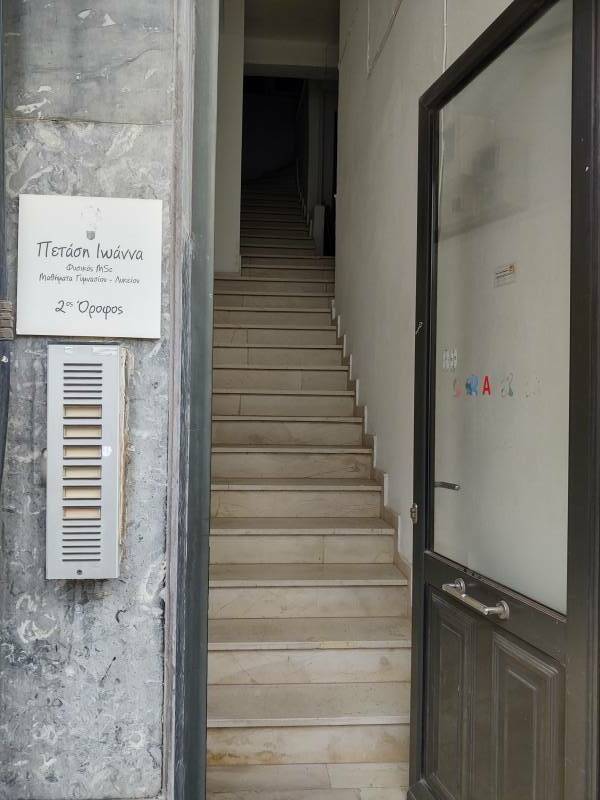
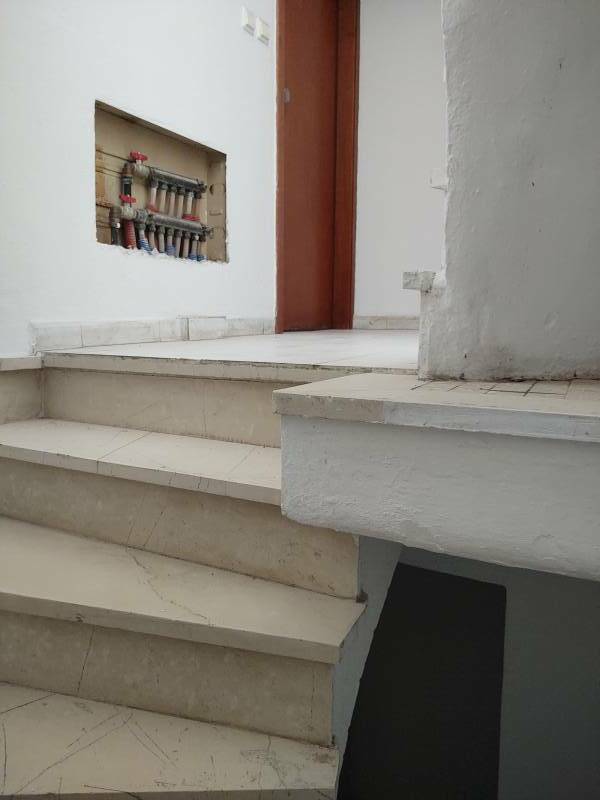
I went upstairs, but the math tutor was the only person with a sign on their door. Handrails aren't a priority in Greece, be careful on the stairs.
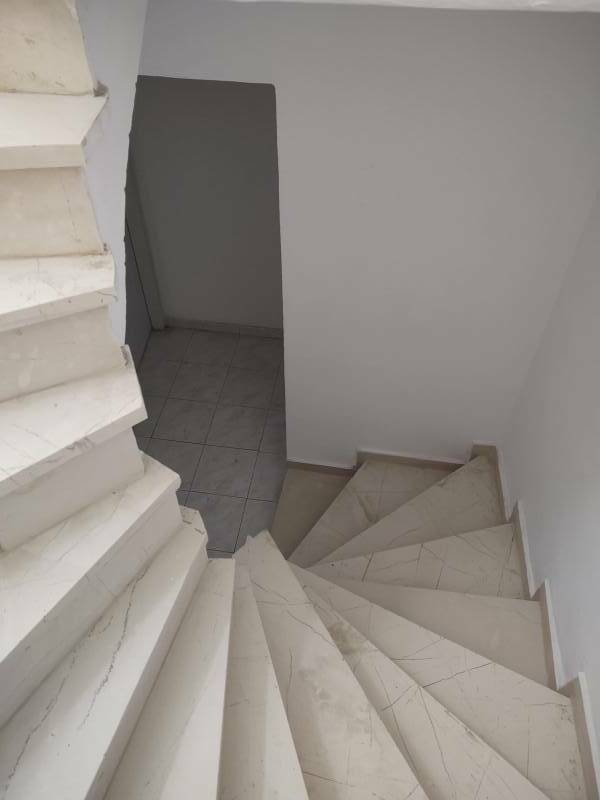
I tried calling my innkeeper, but got voice mail. I left a message, and they called me within a half-hour. Hadn't I found it? Hadn't I noticed that the apartment on the next-to-top floor was unlocked, with the key in the lock?
Well, um, no. I wasn't about to go trying to open doors in an apartment building. This was in late April 2022, with things still gradually re-opening and re-starting after the peak of the COVID-19 pandemic. Many things were different now, including renting rooms. And at least in Greece, it seemed that you were expected to try to open doors.
It was a great place, too bad I was only staying one night!

There was a kitchen, fast wireless Internet, very nice!

This was late April 2022, almost 2.5 years after the COVID-19 pandemic started in December 2019. Hotels and hostels with traditional front desks in or beside a lobby area still operated much the same, although cleaning usually required that guests be out of the space. Otherwise you might meet your host when you arrived, but possibly not at all during your stay. That was the case for me both here in Ierapetra and Sitia.
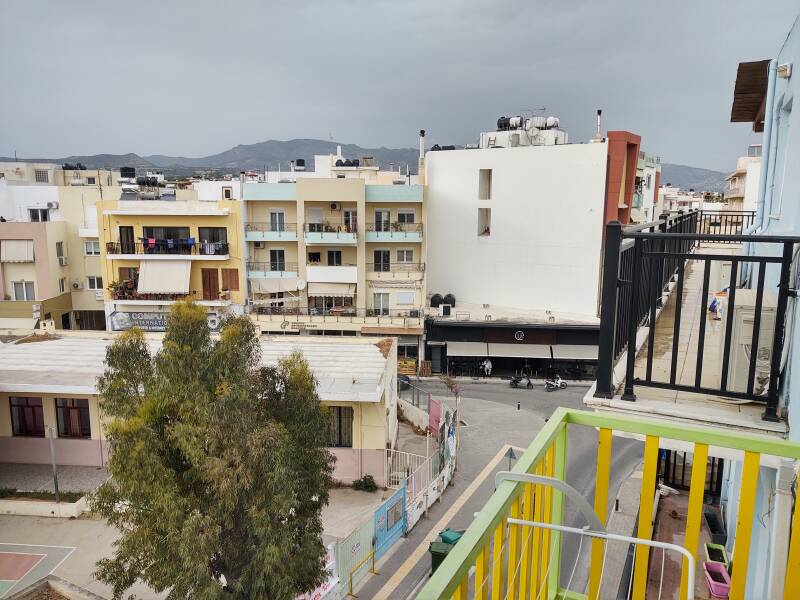
Breakfast the next day was koulouri or κουλούρι, the Greek version of the Turkish simit, a bread ring with sesame seeds. And possibly more, this one had both sesame and flax seeds. Plus a double Greek coffee, of course.
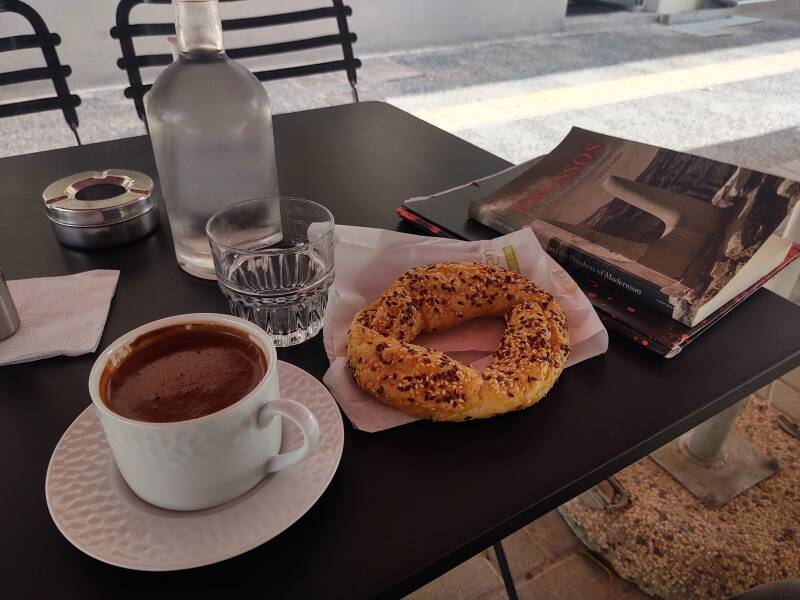
I packed up, cleaned up what little mess I had made, left the key in the apartment door, and stored my things in my car. Then I explored the area of Ierapetra near the waterfront. A little over 12,000 people live in Ierapetra, over 16,000 when you include the surrounding region.
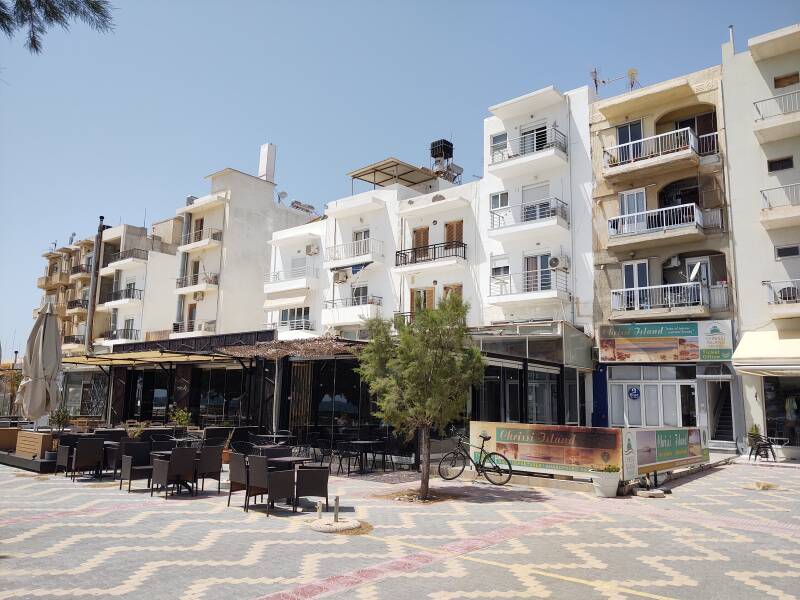
Ierapetra or Ιεράπετρα was a port town during the Minoan era. The Ancient Greek town was built on the Minoan one. Centuries later, Rome took control of this area.
The Mycenaean Greeks knew that the Minoan town had been established long before. They attributed the town to the Corybantes, ecstatic dancers who worshipped the Phrygian goddess Cybele with drumming and dancing. The Cretan equivalents were the Kouretes who worshipped Rhea, the local analogy to Cybele.
Current thought is that the Ancient Greeks were trying to reconcile their early version of Father Zeus with what remained of the Minoan rituals about the Divine Child of Crete.
At the Minoan complex at Agia Triada I had seen a temple dedicated to Welchanos or Ϝελχάνος, a Minoan vegetation deity.
The Minoans seem to have had a pair of deities, a Mother Goddess who was the more powerful of the pair, and a male youth, personified as Welchanos. Mesopotamian-style, they had a mother-and-child relationship and also were in a hieros gamos or ίερός γάμος, a "holy marriage". They were associated with vegetation and fertility, and the seasonal cycle of death and rebirth.
When the Mycenaean Greeks arrived in Crete around 1500 BCE, they identified Welchanos as their own supreme deity. This was a precursor to Zeus, although they didn't call him by that name. To the Mycenaeans he was God of the Sky, di-we or di-wo, 𐀇𐀸 or 𐀇𐀺 in the Linear B script.
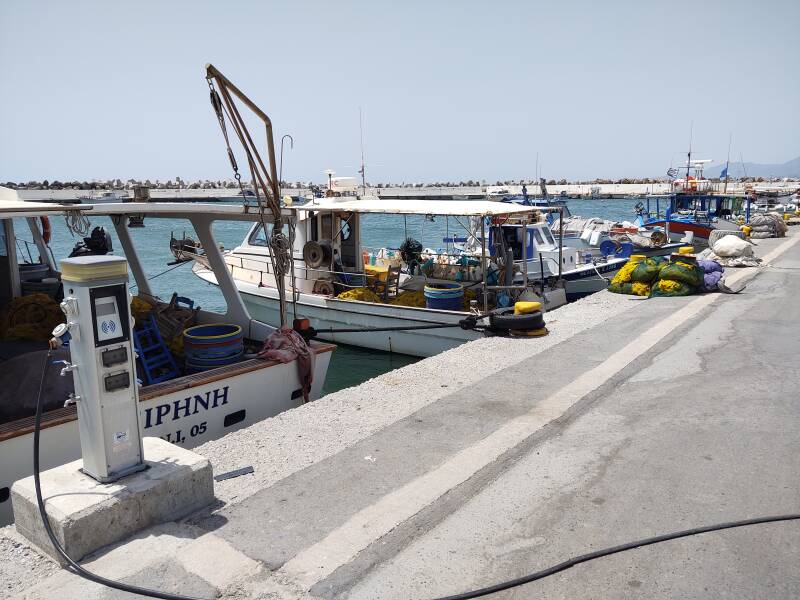
During the Classical Age of the 5th and 4th centuries BCE, Ierapetra became the most powerful Dorian city in eastern Crete.
It became a stronghold of pirates in the 3rd century BCE.
Ierapetra had an ongoing rivalry with Praisos, said to have been the last Minoan city on Crete. That rivalry escalated until the inhabitants of Ierapetra destroyed Praisos in 140 BCE. The people of Praisos moved north, to Sitia. I was soon to drive north past Praisos to Sitia.
Ierapetra was the last free city in Crete, in 67 BCE it was the last to be captured by the Romans. Gortyna became the most powerful city in Crete, as it became capital of the two-part Roman Province of Crete and Cyrenica.
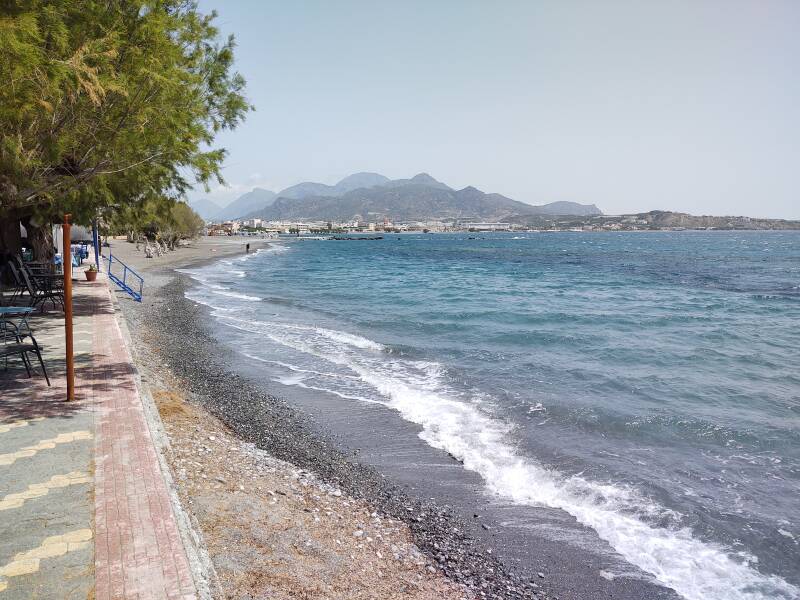
Arab invaders destroyed the city in 824 CE and rebuilt it as a base for pirates.
The western armies of the Fourth Crusade couldn't be bothered with going all the way to Jerusalem. It was a long trek east across Anatolia and then south across the Syrian desert. They got as far as Constantinople and decided that its inhabitants were foreign enough and of an adequately different religion that they should besiege and loot that city. The Byzantine Empire was split into several pieces under the control of various northwestern European factions. The city-state of Venice grabbed much of the Aegean, and came to rule Crete from 1205 until its capture by the Ottoman Empire in 1669.
Ierapetra became prosperous during Venetian rule. In the distance here is a Venetian fortification.
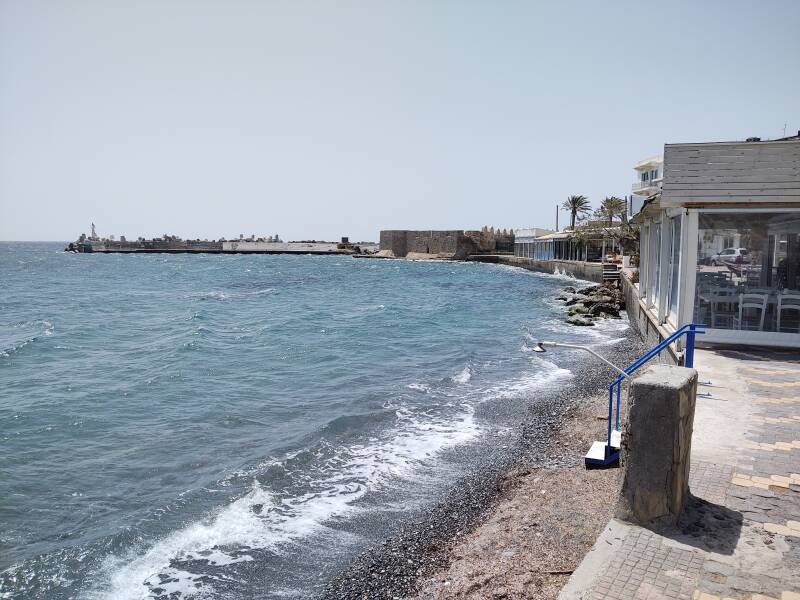
Napoleon Bonaparte, styling himself Napoleon the Great or just simply Napoleon like Cleopatra before him and Cher after him, wanted to drive Britain out of the French Revolutionary Wars. He planned to do that by invading British India. And so his first step in that plan was to invade Egypt in 1798. Napoleon had large and complex plans. He assembled an army of more than 35,000 soldiers and a large fleet of ships at Toulon, in southern France. They sailed from Toulon on 19 May 1798, captured Malta in June, and continued from there toward Egypt on 12 June. The French forces arrived at Alexandria on 1 July 1798.
Visiting thePyramids
Napoleon captured Alexandria and then marched his army south through the desert. On 21 July 1798 they fought what Napoleon called the Battle of the Pyramids, because you could see them from the battlefield. The pyramids at Giza are enormous, the battle was about fifteen kilometers away.
Napoleon's army defeated the main army of the local Mamluk rulers, and wiped out almost all of the Ottoman army in Egypt. Murad Bey, Mamluk chieftain, cavalry commander, and joint ruler of Egypt, fled to Upper Egypt with the remnants of his army. France now ruled Lower Egypt. Napoleon marched his army into Cairo and set up a new national administration.
Things were going great for France in Egypt, at least for the next week and a half. Then, on 1–3 August 1798, Rear Admiral Sir Horatio Nelson led the British Royal Navy in a decisive defeat of the French navy in the Battle of the Nile. No, they didn't take the navies up the river, it was fought off the coast of the Nile Delta. Given the technology of the era, Napoleon didn't learn about his navy's defeat until the 14th. Back home, the French press had reported some rumors on the 7th, but didn't have more complete and credible reports until 26 August. Those were inaccurate, claiming that Nelson was dead and Napoleon was a prisoner of the British.
Napoleon's army was now trapped in Egypt. British sea power along the Syrian coast ended Napoleon's plans to also seize Syria. Napoleon returned to Egypt without his army late in the year.
The whole episode was the beginning of the end of seven centuries of Mamluk rule in Egypt. And, the beginning of British rule over Egypt and surrounding territories.
That much of the story is well known. Then we get to the claims of Ierapetra's involvement.
Maps and guide books briefly mention "Napoleon's House" in Ierapetra without much explanation. Trying to dig deeper, what little information exists is contradictory.
The claim is that Napoleon stayed here, probably for just one night, renting a house from a local family. A local nobleman named Andreas Peroulios owned a house one block in from the waterfront. He rented the house to a traveling stranger for one night. The next day, his wife found a note left under the pillow of the bed saying that the stranger had been Napoleon Bonaparte.
Many of the different variations on the story say that it happened in June 1798, and Napoleon was on his way home to France in shame after his defeat. But he was still on his way to Egypt at that point, about to have an resounding army victory closely followed by a resounding naval defeat. Then he wouldn't return to France until late that year.
The city of Ierapetra bought the house from a descendant of Peroulios. It hadn't been open for visits since long before the COVID-19 pandemic.
It all seems rather dubious, but several local businesses have named themselves after the supposed one-night guest. As for the house, here it is:
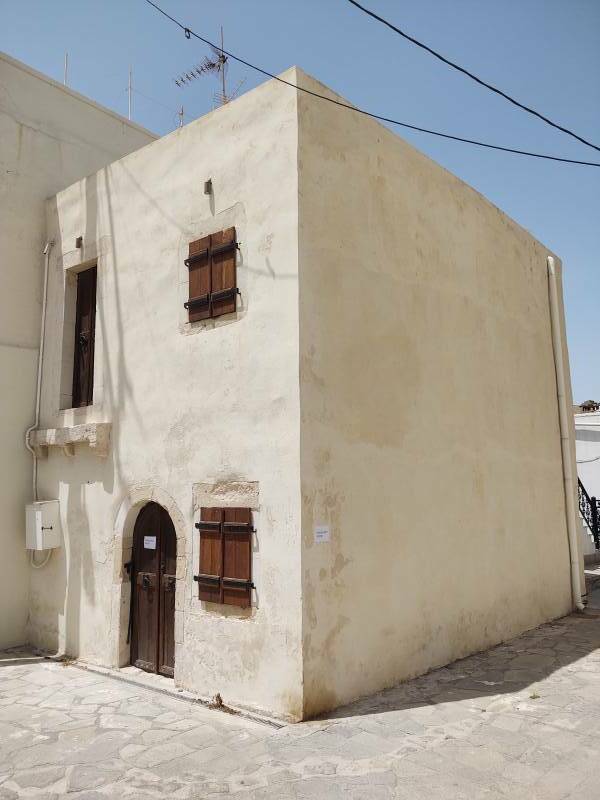
Local promotion of Ierapetra focuses on the fact that it's the southernmost town in Europe. The tip of land south of the Messara Coast stretches 10 kilometers further south. But from there east to Ierapetra, most villages are home to no more than a few dozen people. The largest is Myrtos, with a population of 600 at a recent census.
Ierapetra has become a popular tourist spot in the high season. Things are pretty quiet in late April.
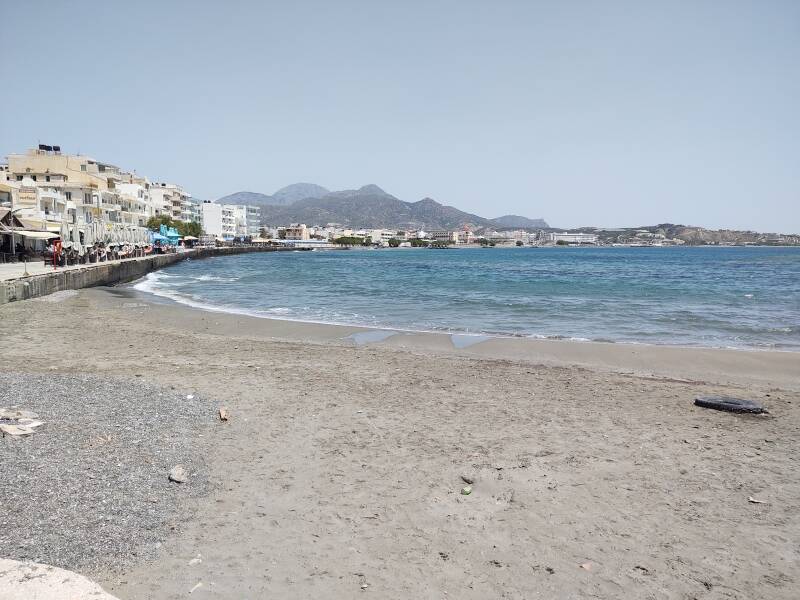
By mid-afternoon of that following day it was time to move on. Ierapetra is near the west or left edge of this map. I would follow the coast road to the east until I was almost due south of Sitia, almost to the Bay (or Ormos) of Makriyialos. Roads follow the less rugged lower-lying area north-northeast to the north coast and Sitia.
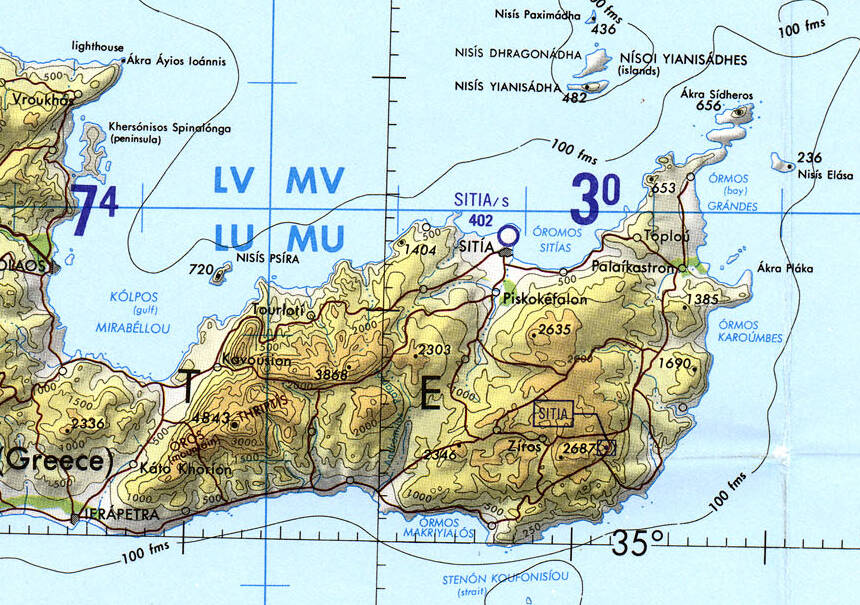
Tactical Pilotage Chart G-3C from the Perry-Castañeda Library Map Collection at the University of Texas at Austin.
I continued further east along the Libyan Sea coast to Makry Gialos, then turned inland to cross the island toward Sitia on the north coast. The route took me through Lithines, Sikia, Praisos, Apano Episkopi, and other small villages.
Along the Coast and Inland
There are beaches and beach resort complexes all the way from Ierapetra to Makry Gialos. Before tourism and greenhouse agriculture arrived, the coastline was mostly uninhabited. The villages were all up in the mountains, hidden from the pirates that operated along the coast for centuries.
Turning inland, the road follows the least rugged path available but still has plenty of twists and turns. It's 22.7 kilometers in a straight line from Makry Gialos to Sitia, but 33.7 kilometers by road, almost exactly one and a half times the distance.
Near Sikia there's a nice view of the Church of Saint George, which the road will soon pass. 214 people lived in the village in 1981, that had dropped to 129 by the next census in 1991.
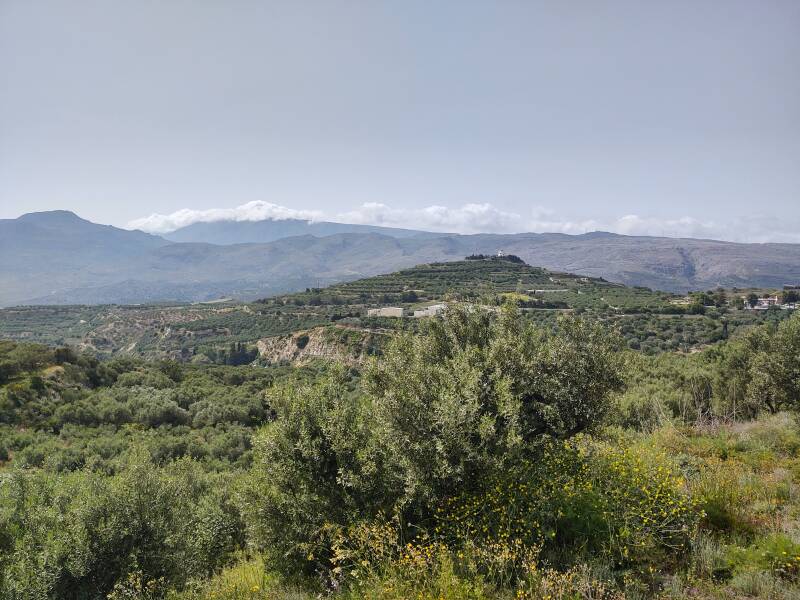
Praisos or Πρεισός is further along, just before reaching Apano Episkopi. The site was occupied in Neolithic times, and both Minoan and Mycenaean artifacts have been found there.
It was a big enough deal for Strabo to mention it, reporting that it had a temple of the Diktaean Zeus, referring to a version of Zeus believed to have been born in the nearby Dikte Cave.
Very little of ancient Praisos remains today, limited remains are scattered over three hills east of the modern village of Nea Praisos.
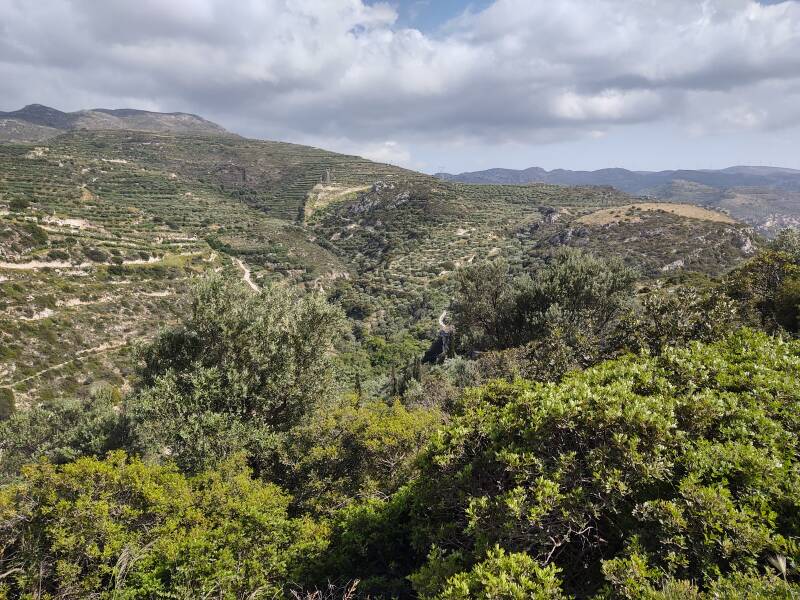
Theophrastus, who lived c. 371 – c. 287 BCE, mentioned Praisos in a dog retrieval story. In his On Love, now lost but described and quoted by Strabo, Theophrastus told how Leucocomas, the beloved of Euxinthetus, gave his lover the task of bringing his dog back from Praisos to Gortyna.
That tale of σκυλοφίλια has been overshadowed by what must be Theophrastus's most famous quote from that work: "Love is the affection of a mind that has nothing better to engage it."
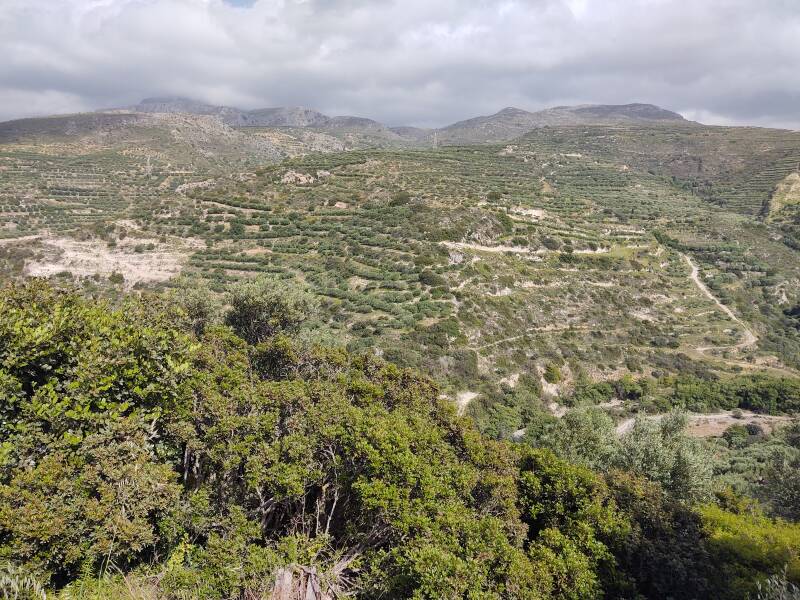
Apano Episkopi
The history of Apano Episkopi or Απάνω Επισκοπή goes back to the Venetian rule of Crete. The Roman Catholic bishop had been based in Sitia, but by the 16th century that location was threatened by pirate raids.
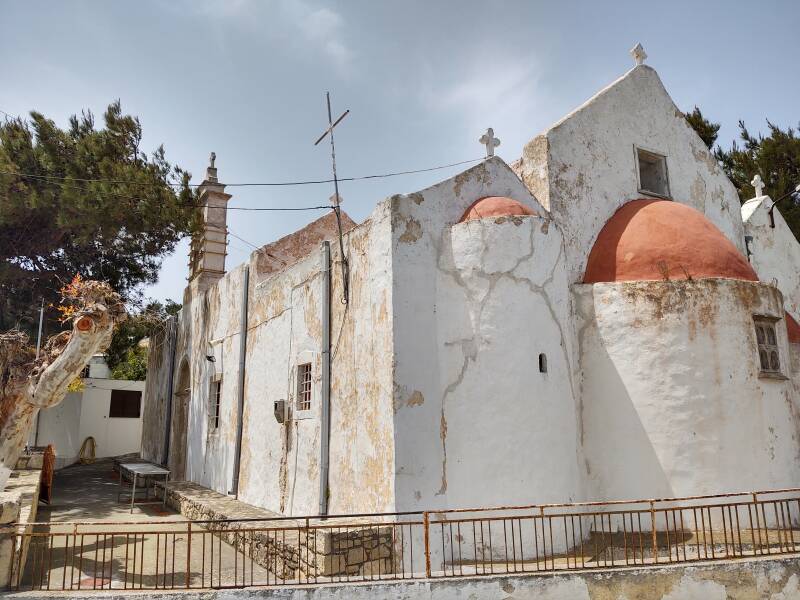
The Roman bishopric was moved here, with the village named Apano Episkopi. The Orthodox bishopric stayed in Kato Episkopi, closer to Sitia.
Apano Episkopi = Upper Diocese
Kato Episkopi = Lower Diocese

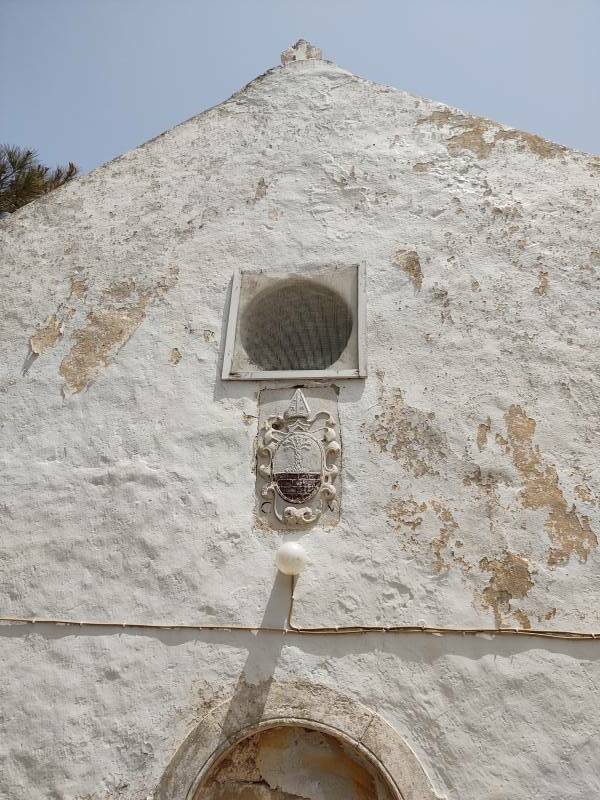
Above the door is the coat of arms of Gaspare Viviani, one of the Roman Catholic bishops.
Apano Episkopi is a very quiet village on a Sunday afternoon.
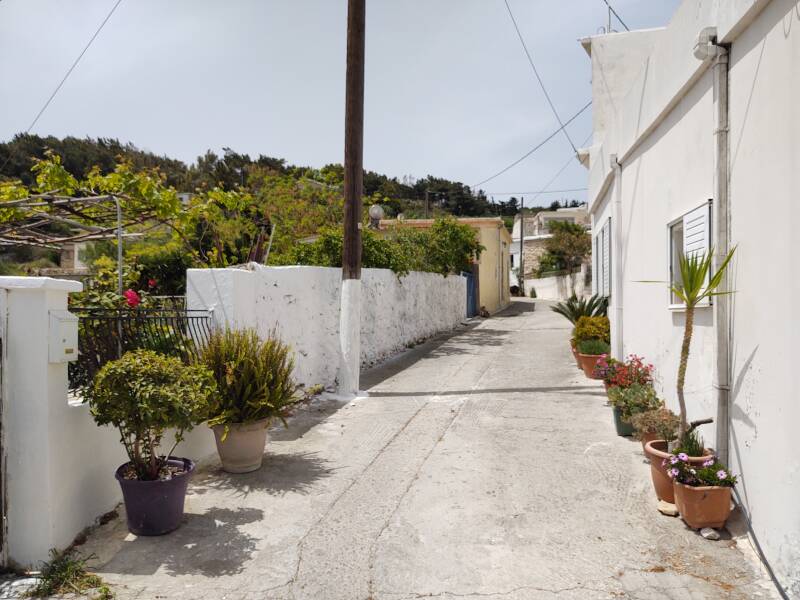
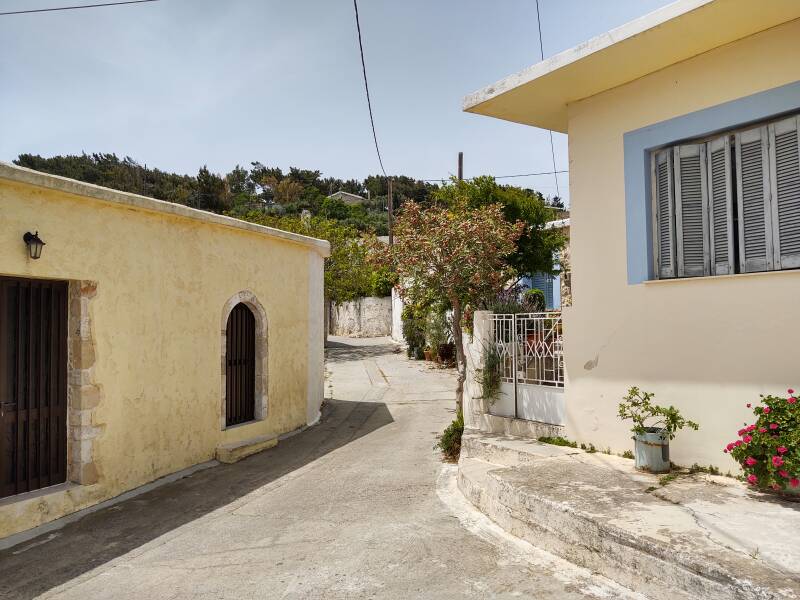
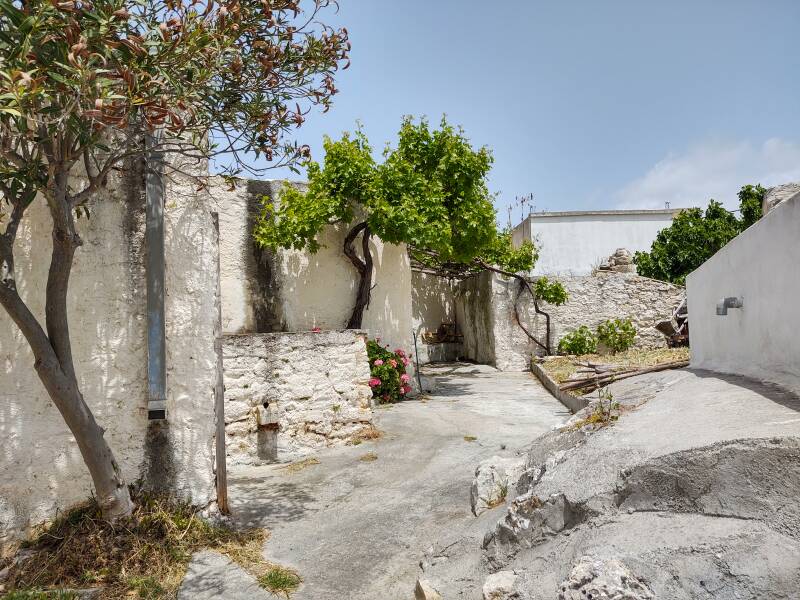

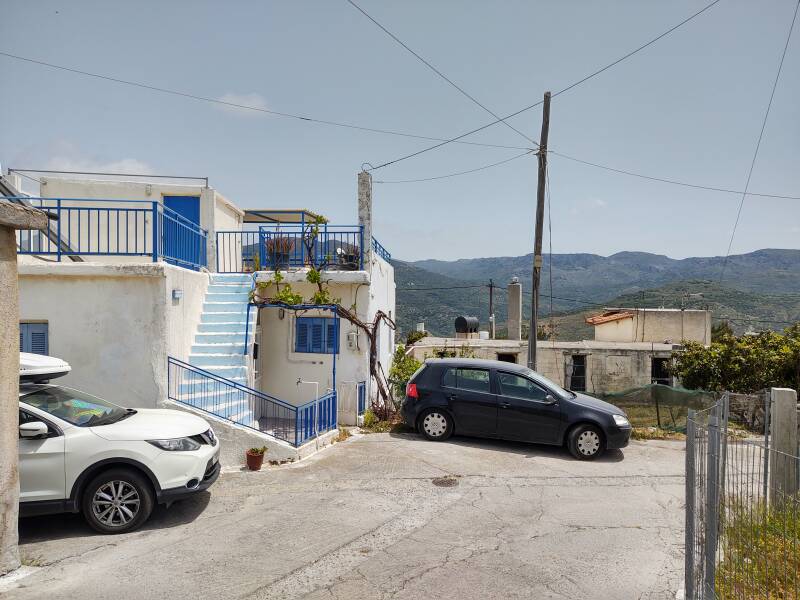
I got back in my car and on the road. Before long I passed through Maronia Siteias or Μαρωνιά Σητείας, one of the larger villages along this route. Just beyond that I came over a rise and could see Sitia and the Aegean Sea in the distance.
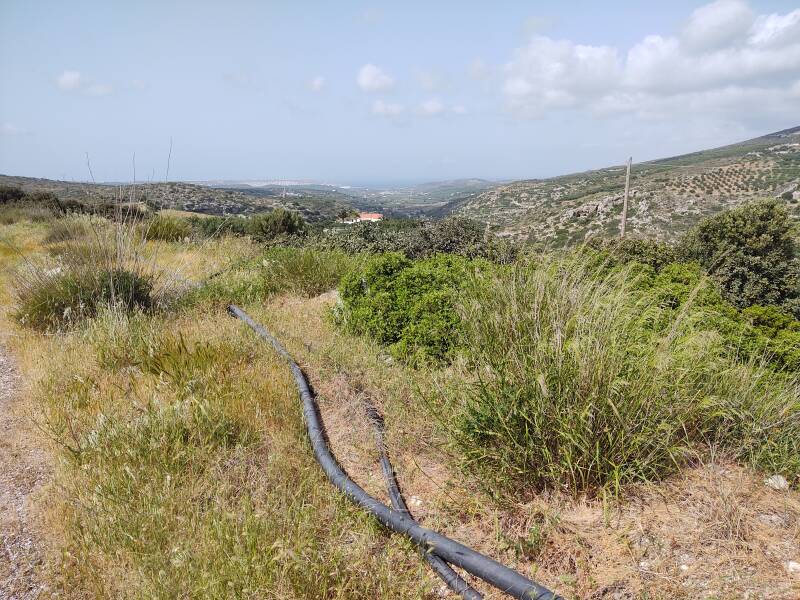
Sitia
Sitia was occupied before the end of Neolithic era around 3000 BCE, and it became a Minoan and then Mycenaean port city through the Bronze Age, 3000–1050 BCE.
Michael Ventris discovered in 1952 that Linear B was used to write the Mycenaean Greek language, an early form of Greek. It seems that the Minoans named the port city Iteia or Itia and the Mycenaeans kept the name.
Sitia continued to prosper through the following Classical Greek, Hellenistic, Roman, and Byzantine periods. The Venetians expanded and fortified it, using it as their eastern Mediterranean headquarters. But then it was destroyed three times during the Venetian occupation, the last time by the Venetians to keep the Ottomans from having it.
Part of Sitia is hilly, going up the slope overlooking the harbor. I had reserved a room at Sergio's Apartment, near the top of Katapoti street. It's an ascent of 60 meters from the waterline.
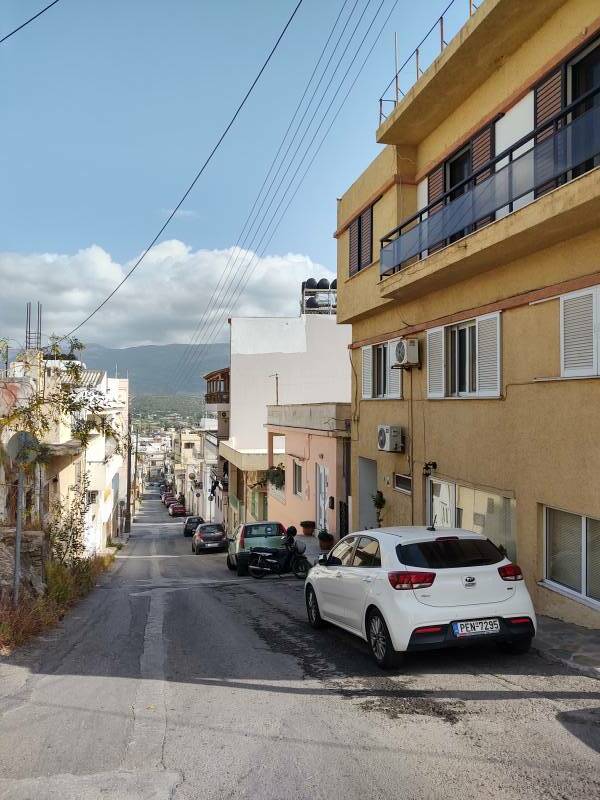

I was pretty sure that Sergio's Apartment was in this building on the corner. But was it really here? And how do I get into the part I had rented?
I thought that it was through the door near the center of the below picture. The door to the left had a "Beware of Dog" sign next to it. I needed to be careful.
So, another quick mobile phone call to an innkeeper. Sergio picked up and explained. Yes, I was correct about it being the door with the closed miniblinds, to the right of the "Beware of Dog" sign. I should just go in, the door is unlocked and the key is inside. Hadn't I tried opening the door? Um, no.
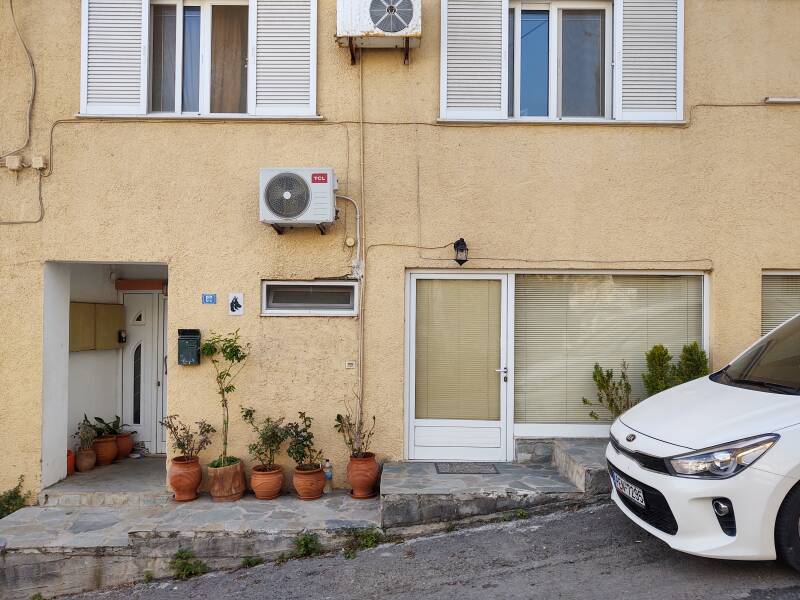
Here's the view stepping in through the door. How nice!
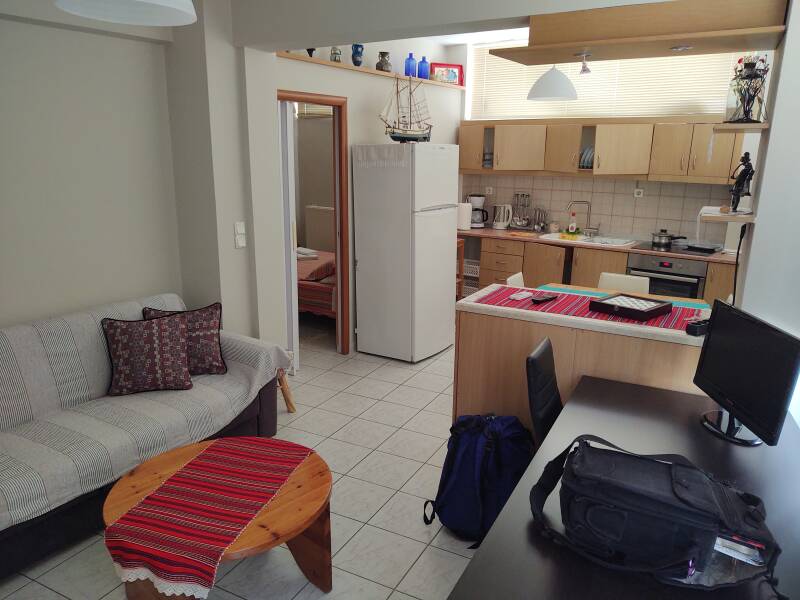
It's a full apartment with a merged kitchen and living room.
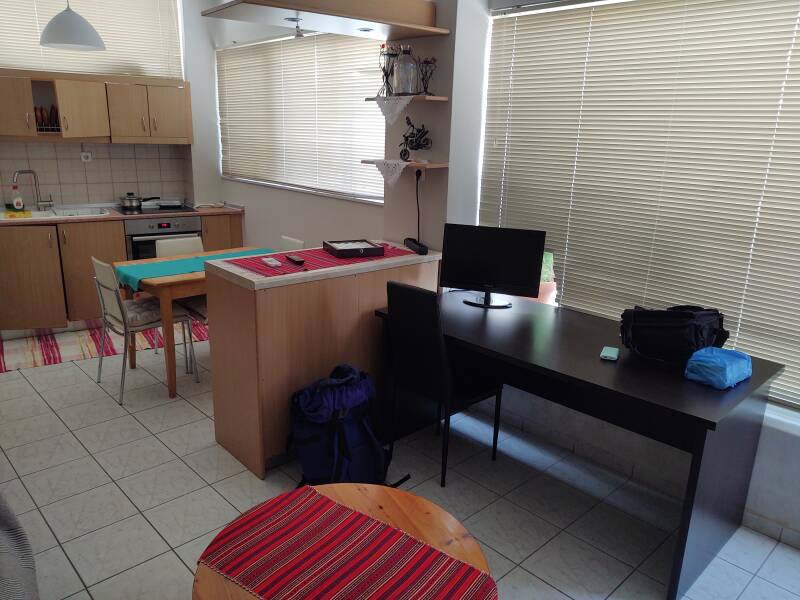
The double bed nearly fills the bedroom.
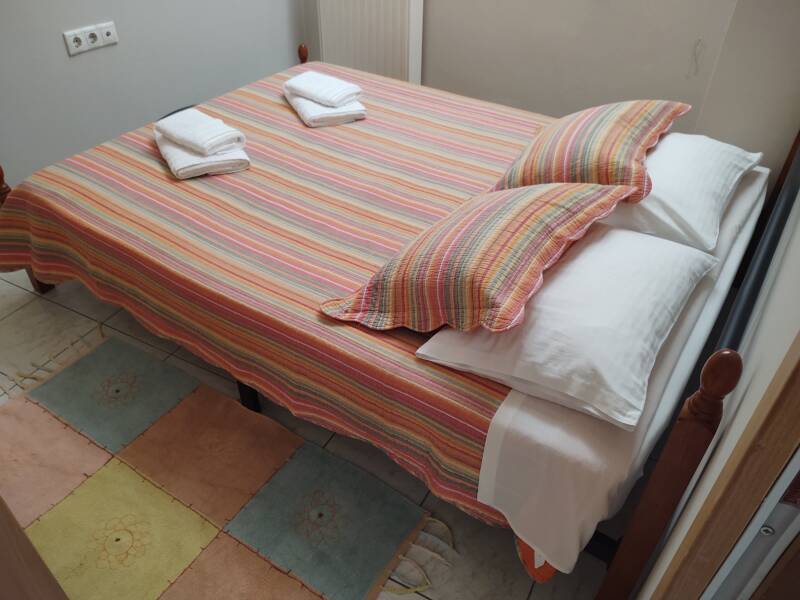
Plus a large bathroom with a clothes washing machine.
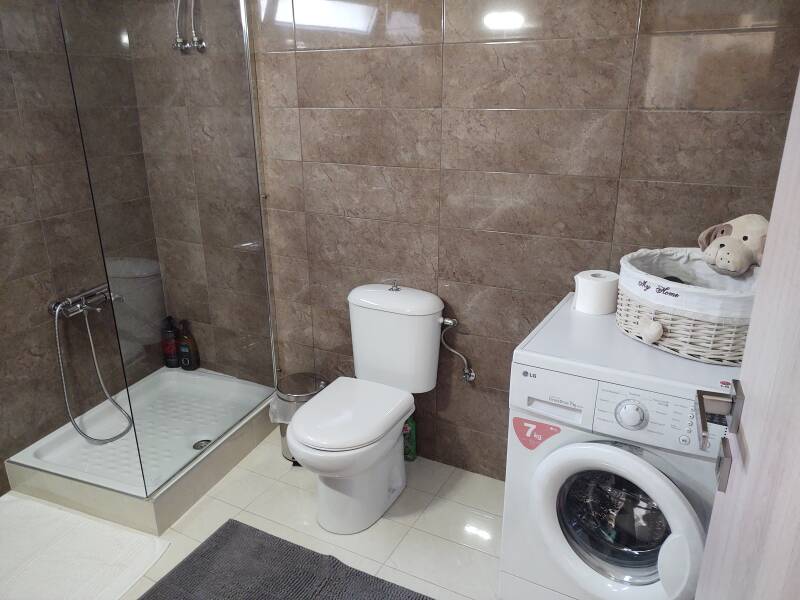
Next❯ Sitia, Kato Episkopi, Minoan villa near Zou
Or, Continue Through Greece:
Where next?
Ϝ Yes, archaic Greek had a /w/ letter, Ϝ/ϝ or Digamma. Mycenaean Greek had a /w/ sound, but it had disappeared from most Greek dialects before the Classical period, so before about 500 BCE.